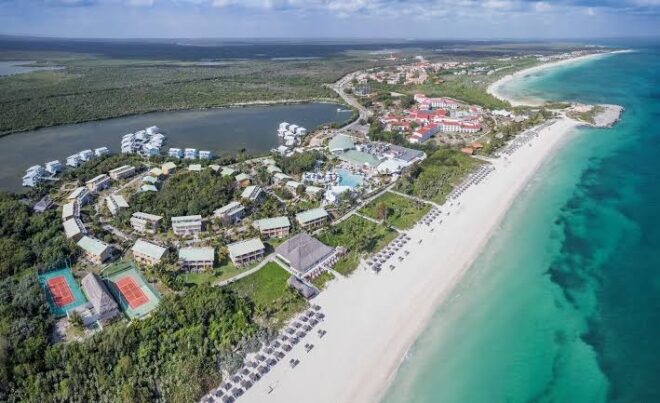
CAYO COCO, CUBA – What began as a picture-perfect tropical holiday for hundreds of international tourists has quickly turned into a troubling health emergency as a mysterious illness spreads through luxury resorts on Cuba’s famed Cayo Beach. Over the last three days, dozens of travelers have reported sudden and severe symptoms, sparking panic among guests and urgent investigations by Cuban health officials.
Located along the pristine northern coast of central Cuba, Cayo Coco and neighboring Cayo Guillermo are among the country’s most popular resort destinations, known for white sands, turquoise waters, and high-end, all-inclusive resorts. But since Saturday, the idyllic surroundings have been overshadowed by a growing health crisis.
Sudden Onset of Symptoms
Guests at four major resorts began complaining of a rapid onset of symptoms including nausea, vomiting, dizziness, stomach cramps, blurred vision, and in some cases, temporary loss of consciousness. While some believed they had fallen victim to a case of food poisoning, the widespread and simultaneous nature of the outbreak quickly raised alarms.
“I thought it was just a bad hangover at first,” said Laura Schmidt, a tourist from Hamburg, Germany. “But then I couldn’t even stand up straight. I felt like I was spinning. I saw people collapsing by the pool. That’s when we knew something was really wrong.”
Within 48 hours, resort medical staff were overwhelmed. Several patients were transferred by emergency boat and helicopter to hospitals in Ciego de Ávila and Havana. As of Monday morning, 12 tourists remained hospitalized, two of them in critical condition.
Investigation Underway
The Cuban Ministry of Public Health (MINSAP) has dispatched epidemiological teams to the resorts to collect samples and conduct interviews. Health officials have sealed off affected resort zones and are working in coordination with international health bodies, including the Pan American Health Organization (PAHO), to determine the cause of the outbreak.
Dr. Ernesto Villanueva, a senior public health official involved in the investigation, told local press that the leading hypotheses include water contamination, airborne toxins, or exposure to harmful marine organisms.
“There is no indication so far of an intentional act,” Dr. Villanueva clarified. “We are examining all possibilities, including environmental and biological sources. Our goal is to identify the source quickly and ensure public safety.”
Initial water and air quality tests have returned inconclusive, though officials noted slightly elevated levels of dinoflagellates—microscopic algae that can produce toxins harmful to humans—along the shoreline near the resorts.
Algae Bloom Concerns
Some scientists believe that an unusual algae bloom, fueled by rising sea temperatures and recent nutrient runoff from inland rains, may be the culprit. Harmful algal blooms, often referred to as “red tides,” are known to produce toxins that can cause neurological and gastrointestinal symptoms in humans through skin contact, inhalation, or ingestion of contaminated seafood.
“This may be a classic case of ciguatera or brevetoxicosis,” said Dr. Mariela Ortiz, a marine biologist at the University of Havana. “These are types of fish poisoning or toxin exposure that can spread quickly among people eating local seafood or even just swimming in affected waters.”
Tourists who fell ill were observed swimming in the ocean, eating freshly caught fish at beachside buffets, and spending extended periods near the water during the heat of the day. Some experts believe toxin exposure may have occurred through a combination of factors.
While similar outbreaks have occurred in parts of Florida, the Caribbean, and Southeast Asia, this would be the first significant case recorded in Cuba in over a decade.
Resort Response and Tourist Reactions
Several resorts have suspended their operations temporarily, canceling all new check-ins and offering partial refunds to affected travelers. Tour operators such as Sunwing, TUI, and Air Canada Vacations have begun rerouting customers and offering alternative destinations.
“We’re doing everything we can to support our guests and ensure their safety,” said a spokesperson for the Melia Cayo Coco Resort. “We’re cooperating fully with health officials and taking proactive steps to sterilize facilities and prevent further exposure.”
Tourists, however, expressed frustration with what they described as slow communication and limited medical resources on site.
“We were left in the dark for hours,” said John Martinez, a visitor from Toronto. “There was no clear information, and the staff didn’t seem prepared for an emergency. It was chaos.”
Some guests documented their experiences on social media, posting videos of people being stretchered out of hotel lobbies and describing symptoms. Hashtags like #CayoCrisis and #CubaOutbreak began trending on platforms such as X (formerly Twitter) and Instagram by Sunday evening.
Broader Implications
The outbreak comes at a difficult time for Cuba, which is struggling to rebuild its tourism sector after years of economic hardship, the COVID-19 pandemic, and ongoing U.S. sanctions. Tourism represents one of the island’s top sources of foreign currency, and Cayo Beach is a crown jewel in its hospitality offerings.
“This couldn’t have come at a worse time,” said Ramon Ferrer, a Cuban economist based in Miami. “Cayo Coco has been a vital part of Cuba’s recovery strategy. An incident like this—especially if it receives global attention—could severely hurt bookings in the coming months.”
International governments, including Canada, Germany, and the United Kingdom, have issued travel advisories urging citizens to avoid non-essential travel to affected areas of Cuba until more information is available.
What Happens Next
Cuban officials have promised a full and transparent investigation and pledged that the resorts will not reopen until the cause of the outbreak is fully understood and mitigated. Independent health experts from the PAHO are expected to arrive within 48 hours.
In the meantime, travelers currently at unaffected parts of the island have been advised to avoid swimming in coastal waters, consume only bottled water, and steer clear of seafood until further notice.
While the incident remains under investigation, tourists like Laura Schmidt are left with unsettling memories. “I came here for sunshine and rest,” she said. “Instead, I got sick, scared, and had to cut my vacation short. I just hope no one else goes through what we did.”